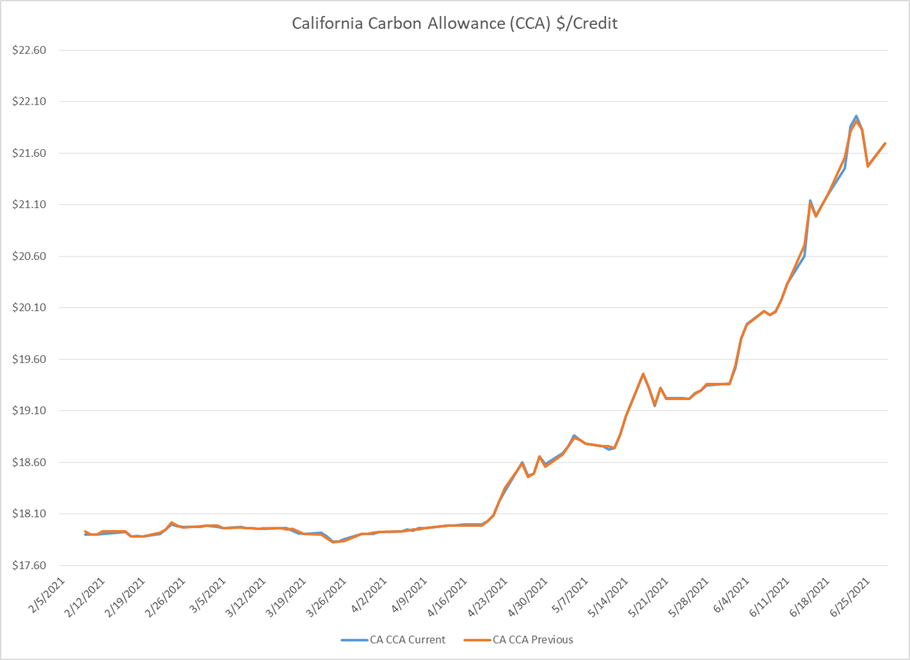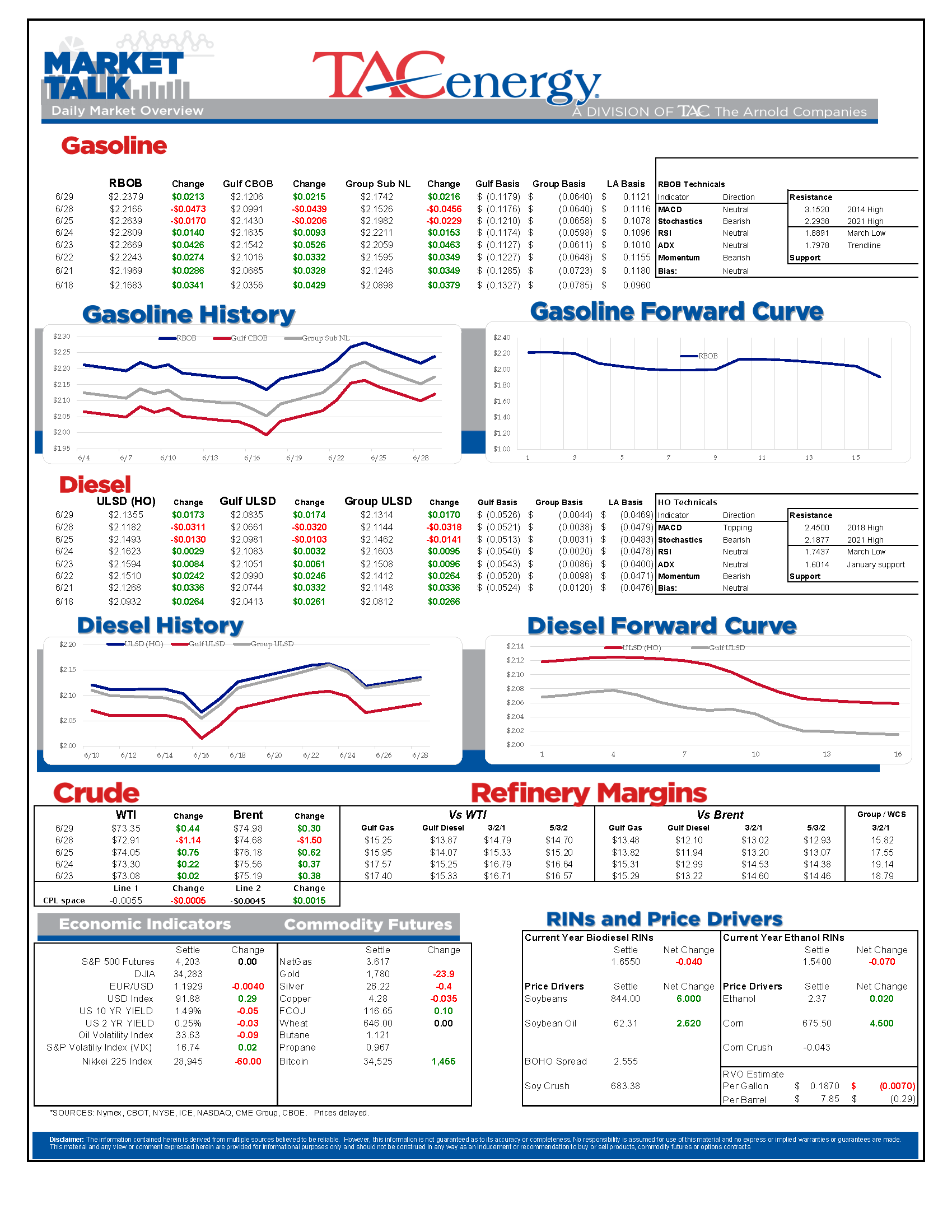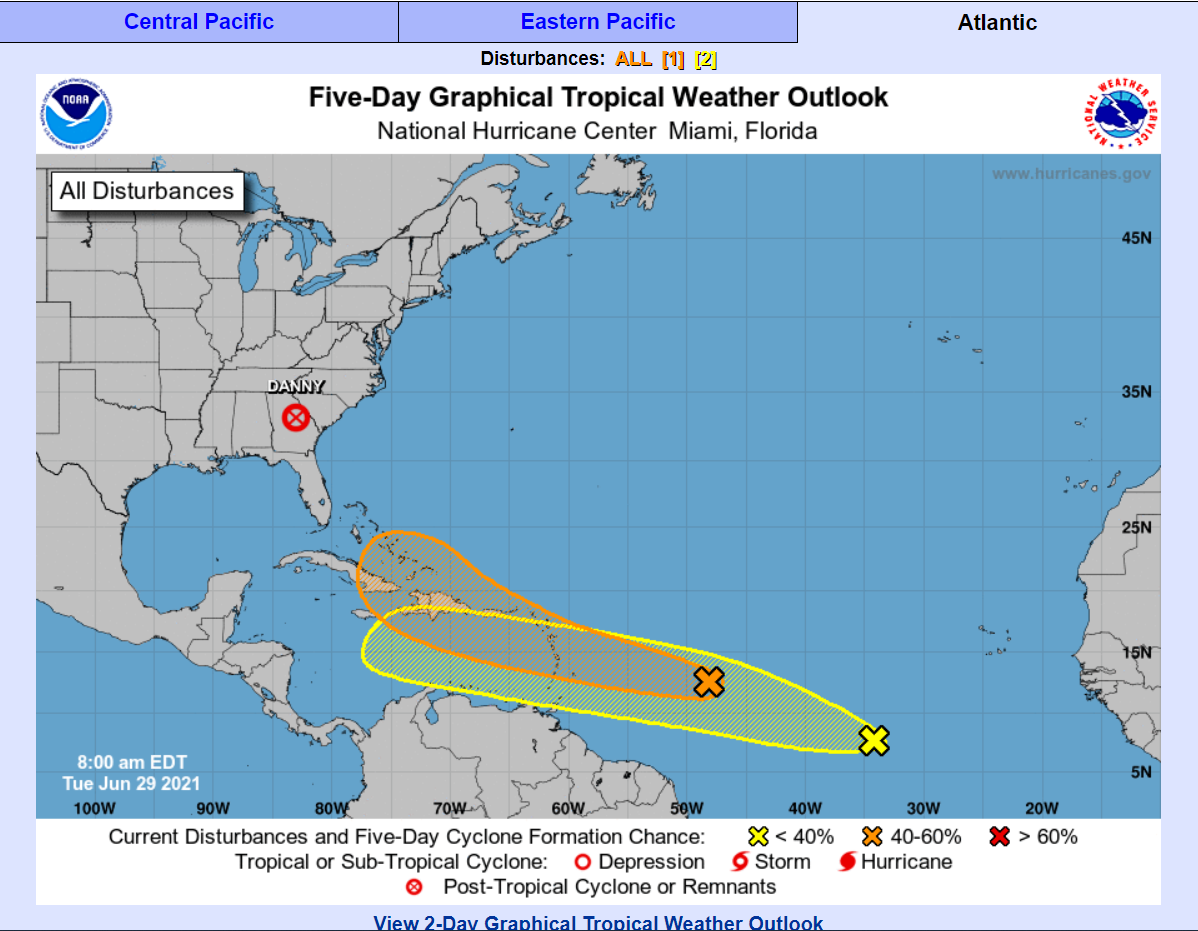Energy Prices Bounce After Worst Daily Selloff In A Month

Energy prices are bouncing after their worst daily selloff in a month Monday, keeping the door open for an extended price rally.
New travel restrictions in a handful of countries due to COVID case spikes took some of the blame for Monday’s sell-off, although from a technical perspective the complex was due for a pullback after the bull rally has pushed prices to multi-year highs. Today’s bounce keeps the trend lines intact, so it’s too soon to say that the rally is over, and those calling for oil prices to reach $80-$100 this year will see the past two sessions as nothing more than a corrective dip.
Tropical Storm Danny made landfall in South Carolina Monday, and has weakened quickly as it moves inland. Two other storm systems are being monitored, but both look like long shots to get into the Gulf of Mexico and become supply threats.
After last week’s Supreme Court ruling that favored small refinery exemptions to the RFS, the EPA is now on the clock to finalize both the RVO requirements for the year (which are already 6 months past due) and to rule on 50 small refinery waiver requests. Not surprisingly, industry groups are not wasting any time lobbying the EPA to see things their way. RIN values did trade higher Monday from where they left off Friday, making for an unusual divergence between RBOB futures which sold off heavily despite the bounce in RINs. Given the close relationship between the two contracts, that could help explain why RBOB is leading the recovery rally this morning.
It’s worth noting that money managers appear to have made a wrong way bet on crack spreads ahead of that Supreme Court ruling, increasing net length in RBOB and ULSD, while reducing length in WTI and Brent. It’s possible that yesterday’s reaction was an unwinding of that trade when it became clear that the latest ruling would not be bullish on crack spreads, but it’s impossible to say given the limited scope of position data available. It’s just as possible that the bullish stance on crack spreads is a play on the St. Croix refinery closing indefinitely after numerous operational mishaps over the past year.
While the big money funds appear mixed on the outlook for oil and refined products, carbon credits remain a hot bandwagon trade with California Carbon Allowance (CCA) positions seeing an increase in net length (bets on higher prices) by money managers for a 6th straight week, even as prices trade at record highs. Given that climate change has become a dominant headline, it’s not surprising to see an influx in hot money into the few contracts that are easily tradeable, and this phenomenon could continue creating volatile swings, similar to what we’ve seen with RINs over the past decade.
Today’s interesting read: How a Salt Lake refinery is using salt to make safer, cleaner, alkylate.
Click here to download a PDF of today's TACenergy Market Talk.
Latest Posts
Energy Markets Rally Again Thursday After A Choppy Wednesday Session
Week 16 - US DOE Inventory Recap
Energy Markets Trading Quietly In The Red As Ethanol Prices Rally To Five-Month High
The Struggle For Renewable Producers Continues As A Rapid Influx Of Supply And Crashing Credit Prices Make Biodiesel
Social Media
News & Views
View All
Energy Markets Rally Again Thursday After A Choppy Wednesday Session
Energy markets are trying to rally again Thursday after a choppy Wednesday session. RBOB gasoline futures are leading the push higher, on pace for a 3rd consecutive day of gains after finding a temporary floor Tuesday and have added 12 cents from those lows.
Equity markets are pointing sharply lower after a weak Q1 GDP estimate which seems to have contributed to a pullback in product prices over the past few minutes, but don’t be surprised if the “bad news is good news” low interest rate junkies start jumping in later on.
The DOE’s weekly report showed sluggish demand for gasoline and diesel, but inventory levels in most markets continue to follow their typical seasonal trends. Refinery runs held fairly steady last week with crude inputs down slightly but total gross throughputs up slightly as most facilities are now back online from a busy spring maintenance season and geared up for peak demand this summer.
Propane and propylene exports spiked to a record high north of 2.3 million barrels/day last week, which demonstrates both the US’s growing influence on global product markets, and the steady shift towards “other” products besides traditional gasoline and diesel in the level of importance for refiners.
The EIA acknowledged this morning that its weak diesel consumption estimates reflected the switch to Renewable Diesel on the West Coast, although they did not provide any timeline for when that data will be included in the weekly survey. The agency acknowledged that more than 4% of the total US consumption is now a combination of RD and Biodiesel, and that number is expected to continue to grow this year. This morning’s note also suggested that weak manufacturing activity was to blame for the sluggish diesel demand across the US, while other reports suggest the freight recession continued through Q1 of this year, which is also contributing to the big shift from tight diesel markets to oversupplied in several regions.
Valero kicked off the Q1 earnings releases for refiners with solid net income of $1.2 billion that’s a far cry from the spectacular earnings north of $3 billion in the first quarter of 2023. The refining sector made $1.7 billion, down from $4.1 billion last year. That is a pattern that should be expected from other refiners as well as the industry returns to a more normal market after 2 unbelievable years. You wouldn’t guess it by looking at stock prices for refiners though, as they continue to trade near record highs despite the more modest earnings.
Another pattern we’re likely to see continue with other refiners is that Renewable earnings were down, despite a big increase in production as lower subsidies like RINs and LCFS credit values sting producers that rely on those to compete with traditional products. Valero’s SAF conversion project at its Diamond Green joint venture is progressing ahead of schedule and will give the company optionality to flip between RD and SAF depending on how the economics of those two products shakes out this year. Valero also shows part of why refiners continue to disappear in California, with operating expenses for its West Coast segment nearly 2X that of the other regions it operates in.

Week 16 - US DOE Inventory Recap

Energy Markets Trading Quietly In The Red As Ethanol Prices Rally To Five-Month High
Energy markets are trading quietly in the red to start Wednesday’s session after a healthy bounce Tuesday afternoon suggested the Israel-Iran-linked liquidation had finally run its course.
There are reports of more Ukrainian strikes on Russian energy assets overnight, but the sources are sketchy so far, and the market doesn’t seem to be reacting as if this is legitimate news.
Ethanol prices have rallied to a 5-month high this week as corn and other grain prices have rallied after the latest crop progress update highlighted risks to farmers this year, lower grain export expectations from Ukraine, and the approval of E15 blends this summer despite the fact it pollutes more. The rally in grain and renewables prices has also helped RIN values find a bid after it looked like they were about to test their 4-year lows last week.
The API reported small changes in refined product inventories last week, with gasoline stocks down about 600,000, while distillates were up 724,000. Crude oil inventories increased by 3.2 million barrels according to the industry-group estimates. The DOE’s weekly report is due out at its normal time this morning.
Total reported another upset at its Port Arthur refinery that’s been a frequent flier on the TCEQ alerts since the January deep freeze knocked it offline and damaged multiple operating units. This latest upset seems minor as the un-named unit impacted was returned to normal operations in under an hour. Gulf Coast basis markets have shrugged off most reports of refinery upsets this year as the region remains well supplied, and it’s unlikely we’ll see any impact from this news.
California conversely reacted in a big way to reports of an upset at Chevron’s El Segundo refinery outside of LA, with CARBOB basis values jumping by more than a dime. Energy News Today continued to show its value by reporting the upset before the flaring notice was even reported to area regulators, proving once again it’s ahead of the curve on refinery-related events. Another industry news outlet meanwhile struggled just to remember where the country’s largest diesel seller is located.
Click here to download a PDF of today's TACenergy Market Talk





